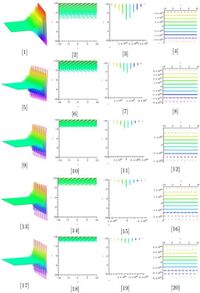This study investigates bifurcation phenomena in the nonlinear time-dependent Schrödinger equation and related models, applying Kudryashov’s methods to derive exact solutions for fractional dynamics. The research extends existing knowledge in fluid dynamics, nonlinear optics, and quantum mechanics by incorporating complex analytical strategies to understand how fractional derivatives impact wave propagation.
The central analysis focuses on two significant equations: the nonlinear time-dependent Schrödinger equation and the space-time modified Benjamin-Bona-Mahony equation. By utilising Kudryashov’s techniques I and II, researchers have successfully derived exact solutions and elucidated how these models exhibit complex behaviors as parameters are varied. This work is paramount for understanding the dynamics of waves in fractional media and highlights the need to refine analytical methods in this domain.
Key findings indicate that bifurcation plays a crucial role in determining the system's stability. The study reveals that through parameter modifications, there are transitions from a single stable fixed point to multiple points, including unstable ones. This bifurcation behavior is characterized by pitchfork bifurcations, which signify profound changes in the system's dynamics.
As the researchers apply Kudryashov’s methods, they establish how these analytical techniques can address complexities introduced by fractional derivatives. Traditional methods such as the Hirota or tanh methods often struggle with non-integer orders; hence, Kudryashov’s methods provide a systematic approach that leads to more accurate solutions. This advancement not only provides clear-cut analytical solutions but also enhances the efficiency of solving complex nonlinear partial differential equations (PDEs) affected by fractional order dynamics.
In one case, the researchers demonstrate how the nonlinear time Schrödinger equation showcases pitchfork bifurcation as parameters cross critical thresholds. More specifically, the nature of solutions changes significantly – oscillatory behavior denotes stability in some configurations, while other scenarios lead to exponentially growing perturbations indicating instability. This highlights the critical nature of stability analysis in nonlinear wave studies.
Figures accompanying the study depict the real and imaginary components of the solutions derived through Kudryashov’s methods, evidenced in different configurations of the beta derivative. These graphs substantiate the theoretical findings and visualize the impact of parameter variations on wave stability and morphology, providing a clearer picture of how such dynamics evolve over time.
The implications of this research are wide-ranging. It offers insights that could lead to advancements in optical technologies and quantum computing, where wave dynamics are essential for efficiency and performance. These findings suggest that controlling wave behavior through fractional dynamics may yield new methods for applied physics, particularly in the manipulation of light and matter interactions.
Ultimately, this research accentuates the innovative application of Kudryashov’s techniques in bifurcation analysis and presents a compelling argument for the relevance of fractional derivatives in contemporary scientific discourse. The authors conclude, "This work not only enhances our understanding of nonlinear wave propagation in fractional systems but also demonstrates the efficacy of Kudryashov’s techniques in tackling the challenges posed by fractional differential equations." As the study urges further exploration, it paves the way for future investigation into nonlinear media, expanding our comprehension of phenomena that govern complex systems.




